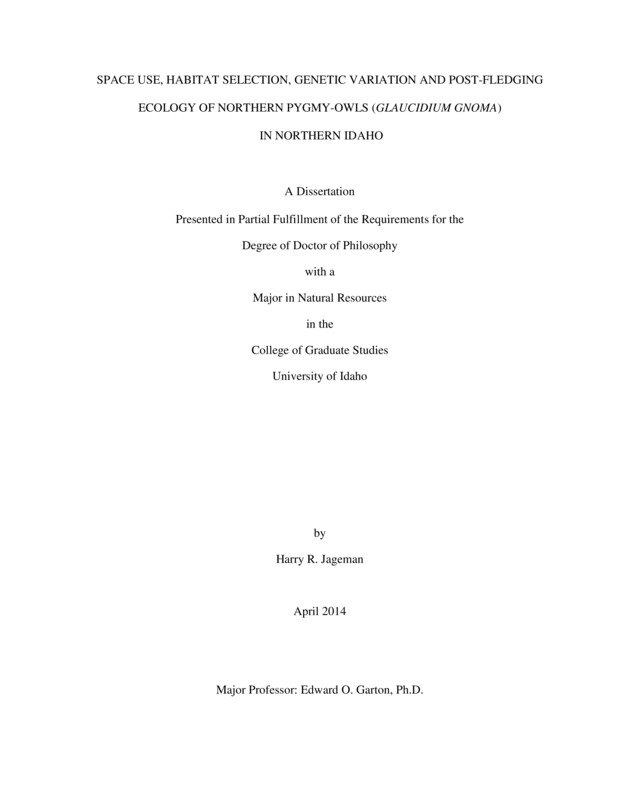Space Use, Habitat Selection, Genetic Variation and Post-fledging Ecology of Northern Pygmy-Owls (Glaucidium Gnoma) in Northern Idaho
Jageman, Harry. (2014). Space Use, Habitat Selection, Genetic Variation and Post-fledging Ecology of Northern Pygmy-Owls (Glaucidium Gnoma) in Northern Idaho. Theses and Dissertations Collection, University of Idaho Library Digital Collections. https://www.lib.uidaho.edu/digital/etd/items/jageman_idaho_0089e_10192.html
- Title:
- Space Use, Habitat Selection, Genetic Variation and Post-fledging Ecology of Northern Pygmy-Owls (Glaucidium Gnoma) in Northern Idaho
- Author:
- Jageman, Harry
- Date:
- 2014
- Keywords:
- Glaucidium gnoma Intraguild Predation Northern Idaho Northern Pygmy Owl Post-fledging Synoptic Model
- Program:
- Natural Resources
- Subject Category:
- Wildlife management
- Abstract:
-
In this dissertation, I investigate various aspects of the ecology of Northern Pygmy-owls (Glaucidium gnoma) in Northern Idaho. The dissertation includes three chapters and a previously published article on post-fledging ecology (Frye and Jageman 2012). Chapter one examines space use and habitat selection of Northern Pygmy-Owls. To test for habitat selection, I developed forty-one a priori models and used two different analysis methods (logistic regression and the synoptic model) to compare results. Results were similar between methods and indicated that two variables (vegetation structural stage) and (distance to stream) were most important in predicting the probability of use by Northern Pygmy-Owls, which selected forested habitats with larger tree sizes and preferred areas closer to stream courses.
Chapter two discusses losses of Northern Pygmy-Owls to intraguild predation by larger raptors. The study suggests Northern Pygmy-Owls utilizing fragmented landscapes are more vulnerable to predation loss than their counterparts that utilize more forested landscapes
In chapter three, I examine genetic variation of Northern Pygmy-Owls in Idaho as compared to individual owls from Montana and British Columbia. I found no genetic differences or clustering in samples from Idaho, Montana, or British Columbia. No unique alleles were found in either Montana or British Columbia that distinguish them from Idaho birds, despite these populations being 300-500 kilometers (km) from the Idaho population. Thus, the results did not corroborate the current subspecies status of G. g. swarthi of British Columbia and G. g. pinicola of Idaho and Montana. Genetic analysis accurately (100%) assigned gender to birds of known sex and in most other instances was congruent with the "projected" gender that was assigned by owl weight and behavior prior to DNA analysis.
In appendix H, I incorporate an earlier article that was published in the Wilson Bulletin in June 2012 (Frye and Jageman 2012). This article discusses post-fledging behavior of Northern Pygmy-Owls from this study and a similar study in Western Montana. Northern Pygmy-Owl adults were found to continue to feed and associate with their young for 9 to 34 days following the departure of the young from the nest.
- Description:
- doctoral, Ph.D., Natural Resources -- University of Idaho - College of Graduate Studies, 2014
- Major Professor:
- Garton, Edward O.
- Committee:
- Kavanagh, Kathleen L.; Strand, Eva K.; Vierling, Kerri T.
- Defense Date:
- 2014
- Identifier:
- Jageman_idaho_0089E_10192
- Type:
- Text
- Format Original:
- Format:
- application/pdf
- Rights:
- In Copyright - Educational Use Permitted. For more information, please contact University of Idaho Library Special Collections and Archives Department at libspec@uidaho.edu.
- Standardized Rights:
- http://rightsstatements.org/vocab/InC-EDU/1.0/

